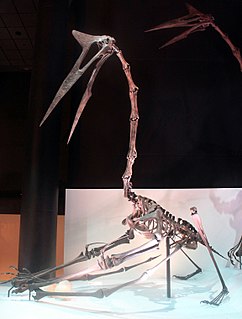
Quetzalcoatlus is a pterosaur known from the Late Cretaceous period of North America ; it was one of the largest known flying animals of all time. Quetzalcoatlus is a member of the family Azhdarchidae, a family of advanced toothless pterosaurs with unusually long, stiffened necks. Its name comes from the Aztec feathered serpent god, Quetzalcoatl, in Nahuatl. The type species is Q. northropi, named by Douglas Lawson in 1975; the genus also includes the smaller species Q. lawsoni, which was known for many years as an unnamed species before being named by Brian Andres and Wann Langston Jr. (posthumously) in 2021.

Bovines comprise a diverse group of 10 genera of medium to large-sized ungulates, including cattle, bison, African buffalo, water buffalos, and the four-horned and spiral-horned antelopes. The evolutionary relationship between the members of the group is still debated, and their classification into loose tribes rather than formal subgroups reflects this uncertainty. General characteristics include cloven hooves and usually at least one of the sexes of a species having true horns. The largest extant bovine is the gaur.

Cyprinus is the genus of typical carps in family Cyprinidae. Most species in the genus are of East Asia origin with only the common carp in Western Asia and Europe; this invasive species has also been introduced to many other regions around the world. Cyprinus are closely related to some more barb-like genera, such as Cyclocheilichthys and Barbonymus (tinfoils). The crucian carps (Carassius) of western Eurasia, which include the goldfish, are apparently not as closely related.
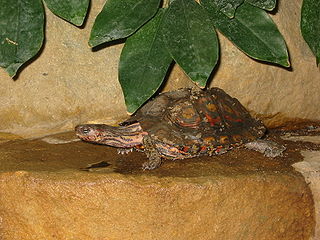
The Geoemydidae are one of the largest and most diverse families in the order Testudines (turtles), with about 70 species. The family includes the Eurasian pond and river turtles and Neotropical wood turtles.
Species diversity is the number of different species that are represented in a given community. The effective number of species refers to the number of equally abundant species needed to obtain the same mean proportional species abundance as that observed in the dataset of interest. Meanings of species diversity may include species richness, taxonomic or phylogenetic diversity, and/or species evenness. Species richness is a simple count of species. Taxonomic or phylogenetic diversity is the genetic relationship between different groups of species. Species evenness quantifies how equal the abundances of the species are.

Amebelodon is a genus of extinct proboscidean belonging to Amebelodontidae, a group of proboscideans related to the modern elephants and their close relative the mammoth. The most striking attribute of this animal is its lower tusks, which are narrow, elongated, and distinctly flattened with the degree of flattening varying among the different species. Two valid species are currently placed within this genus, which was endemic to North America. Other species once assigned to Amebelodon are now assigned to the genus Konobelodon, which was once a subgenus.
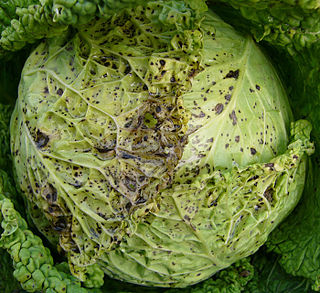
Tymoviridae is a family of single-stranded positive sense RNA viruses in the order Tymovirales. Plants serve as natural hosts. There are 42 species in this family, assigned to three genera, with two species unassigned to a genus.

Morinda is a genus of flowering plants in the madder family, Rubiaceae. The generic name is derived from the Latin words morus "mulberry", from the appearance of the fruits, and indica, meaning "of India".
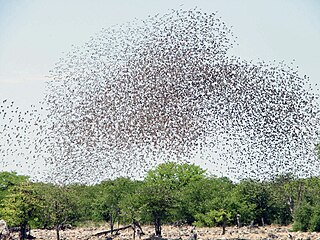
Quelea is a genus of small passerine birds that belongs to the weaver family Ploceidae, confined to Africa. These are small-sized, sparrow- or finch-like gregarious birds, with bills adapted to eating seeds. Queleas may be nomadic over vast ranges; the red-billed quelea is said to be the most numerous bird species in the world.

Clemmys is a genus of turtles currently containing a single extant species, the spotted turtle (Clemmys guttata).

Quinkana is an extinct genus of mekosuchine crocodylians that lived in Australia from about 24 million to about 40,000 years ago. Most attributed specimens have been found in Queensland. It is speculated to have been one of the top predators of Pleistocene Australia.

Gracillariidae is an important family of insects in the order Lepidoptera and the principal family of leaf miners that includes several economic, horticultural or recently invasive pest species such as the horse-chestnut leaf miner, Cameraria ohridella.

Eupterotidae is a family of insects in the order Lepidoptera with more than 300 described species.

Nurhachius is a genus of istiodactylid pterodactyloid pterosaur from the Barremian to Aptian-age Lower Cretaceous Jiufotang Formation of Chaoyang, Liaoning, China. Its fossil remains dated back about 120 million years ago.

Triplophysa is a genus of fish in the family Nemacheilidae found mainly in and around the Qinghai-Tibet Plateau in China. Currently, the genus is a mixed assemblage of species. Some lineages have been identified and treated as subgenera, but as Wikipedia follows Fishbase for fish species all but Hedinichthys have been treated as subgenera in Wikipedia, although Kottelat in his revision of the loaches did recognise them as valid. FishBase, however, includes these in Triplophysa without specifying subgenera and treats the names given by Kottelat as synonyms.

The Catostomidae are the suckers of the order Cypriniformes, with about 78 species in this family of freshwater fishes. The Catostomidae are almost exclusively native to North America. The only exceptions are Catostomus catostomus, found in both North America and Russia, and Myxocyprinus asiaticus found only in China. In the Ozarks they are a common food fish and a festival is held each year to celebrate them. Ictiobus cyprinellus can reach an age up to 112 years, making it the oldest known freshwater teleost.

The Nemacheilidae, or stone loaches, are a family of cypriniform fishes that inhabit stream environments, mostly in Eurasia, with one genus, Afronemacheilus found in Africa. The family includes about 790 species.

Sulcavis is a genus of enantiornithean birds. One species is named, Sulcavis geeorum. The fossil was found in Early Cretaceous rocks in Liaoning Province, China.
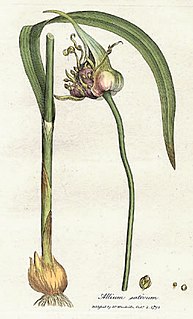
Allium is a genus of monocotyledonous flowering plants that includes hundreds of species, including the cultivated onion, garlic, scallion, shallot, leek, and chives. The generic name Allium is the Latin word for garlic, and the type species for the genus is Allium sativum which means "cultivated garlic".
Lanonia is a genus of fan palms, in the tribe Trachycarpeae. It has a recorded native range from southern China to Indo-China and is also found in Java.

















